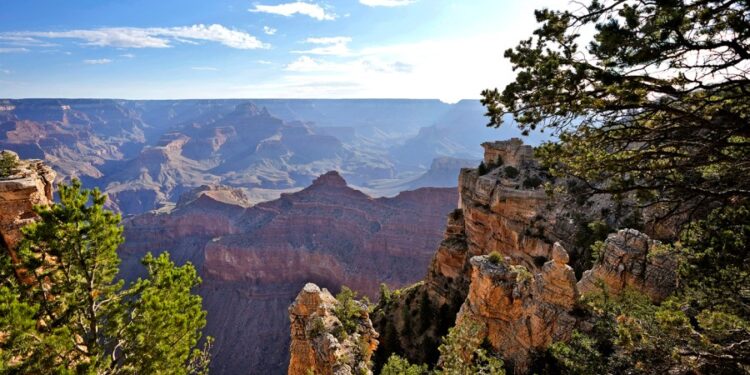
Multiple hikers have died this summer in the Grand Canyon National Park — a U.S. West landscape known not only for its rugged beauty, but also for its perilous weather extremes.
Within the past week, National Park Service (NPS) officials have reported three fatalities in a region plagued by both excessive, dry heat and flood-fueled river rapids.
Rescue personnel on Wednesday located the body of a 60-year-old man who had lost contact with family on a solo, multiday trip on Thunder River Trail in the park’s north. Although a Thursday report did not elaborate on the cause of death, NPS materials describe Thunder River access as “difficult, sometimes impossible,” but with a promise of “something close to canyon perfection.”
The backpacker’s body was found during an already deadly week. On Sunday morning, the officials announced they had found the body of a 33-year-old woman, Chenoa Nickerson, above the confluence of Havasu Creek and the Colorado River. A multiday search-and-rescue mission took place after Nickerson disappeared in a torrential rainstorm.
The same day Nickerson went missing, the resident Havasupai Tribe likewise reported devastating flash floods, which damaged “the main trail to Supai Village, trails within the village, tribal member homes, public utility systems and the campgrounds.”
It is unclear whether climate change-induced weather conditions have contributed to the onslaught of Grand Canyon deaths this year.
Heather Klein Olson, executive director of the American Hiking Society, said she believes the fatalities stem from a combination of factors, including a climate-driven increase in intense and more frequent rainfall events, as well as land use changes that have altered water flow.
In addition to such shifts, which include both park-adjacent development and deforestation, Klein Olson pointed to “increased foot traffic over the past couple years, especially since COVID.”
That pandemic-linked influx of visitors to park lands has effectively exposed a greater pool of people to flood-related risks, she explained.
“Everyone is interested and wants to get outside, and it’s beautiful, and we love our outdoors,” Klein Olson continued. “But there’s also a variety of factors that have to be considered when we get outside.”
There have been 14 fatalities at Grand Canyon National Park this season, just below than the annual average of about 15 deaths, NPS spokesperson Rebecca Roland told The Hill. With the monsoon period — July to September — still underway, she stressed that hikers should remain aware of flash floods and excessive heat.
“The arid, sparsely vegetated environment here means that rainfall quickly generates runoff because the ground doesn’t absorb it well,” Roland said in an emailed statement. “This runoff moves rapidly through narrow canyons and steep terrain, turning dry streambeds into torrents of water within minutes, even from relatively small storms.”
Roland suggested that visitors refer to the NPS Grand Canyon Weather Dangers website for detailed guidelines, adding that parks officials and Grand Canyon Conservancy volunteers operate an active, preventative search and rescue team. This group, she explained, also educates hikers on-site, asks them critical questions and encourages people to turn back if there is a concern.
Last Sunday, the same day Nickerson’s body was discovered, parks personnel responded by helicopter to an alert about an 80-year-old man whose boat had flipped over, sending him into the Colorado River. Resuscitation attempts proved unsuccessful, according to the NPS.
Earlier in the month, on Aug. 6, NPS personnel identified the body of a 20-year-old woman, noting that “despite facing inclement weather and hazardous terrain, the team has undertaken significant risks to complete these missions.” Less than a week before, rangers located the body of a man who had tried to BASE jump — a forbidden sport that involves jumping from fixed objects — and that of a 20-year-old man who died in a fatal fall.
These incidents followed three reports of male hiker deaths: a 50-year-old on July 7, a 69-year-old on June 29 and a 41-year-old on June 17. With the death toll on the rise, the NPS warned visitors that trail temperatures could “reach over 120°F (49°C) in the shade.”
From 2007 through the end of June, there were 216 deaths in Grand Canyon National Park, according to an NPS mortality dataset that is updated on a quarterly basis.
Of all the deaths since 2007, 48 occurred during hikes and 23 were related to either swimming or vessel-use, which mostly resulted in drowning incidents. Seven people died while taking photos, six while walking, two while climbing and two during BASE jumping. Another 27 deaths were deemed suicides, while the causes of most others were either undetermined or not reported.
Klein Olson drew particular attention to photography as a distracting endeavor, noting the dangers of “selfies, walking while taking photos, getting too close to the edge of a cliff and taking photos.”
“Our natural spaces have been around for as long as we have, and longer,” she said. “It is really up to [the] individual, to take care of themselves and to know the risks and to prepare themselves.”
“They are natural environments. They are dangerous,” she added.
Klein Olson recommended that hikers always refer to the American Hiking Society’s “Ten Essentials” list, which includes the top-priority items that should go into a trekking pack.
Those items include appropriate footwear, navigation tools, water, food, weather-adaptive layers, safety supplies, a first aid kit, a knife, sun protection and shelter.
Klein Olson likened the preparation necessary for a Grand Canyon hike to the steps she needs to take prior to scuba diving. Recognizing that “it’s dangerous to scuba dive,” she stressed the importance of preparing for “an unknown environment.”
“When you’re hiking a trail you’ve never hiked before, that’s an unknown environment,” Klein Olson said, reiterating the need to prepare for all the possible elements.
“Unfortunately, that’s contributing to a lot of the accidents,” she added.






